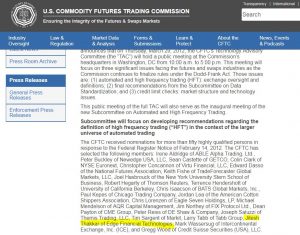31
Jan, 2018
31
Jan, 2018
Flash Crash Spoofer Aids CFTC in Finding Other Spoofers, Which Include Big Banks and People Who Served on the CFTC’s Technology Advisory Committee. Wait What?
Many of you remember the May 6th 2010 Flash Crash. Many of you remember that the CFTC arrested the UK’s Navinder Sarao and pegged him as having cause that Flash Crash. He pleaded guilty in November 2016 and pledged to cooperate with the CFTC. We wrote about Navinder Sarao to you several times:
- The UK Flash Crash Spoofer Case Brings More Questions Than Answers
- Where Were the Regulators?
- Enforcement?
Some interesting snippets from our prior notes on Sarao:
- Considering the thousands of traders around the globe that have access to much more sophisticated software and hardware, we have to believe that Sarao is not the only person running these sorts of manipulative strategies. Even Sarao admitted to regulators that he knew of another trader doing the same thing. The DOJ case stated: Referring to another trader, SARAO further asked, “I see he continues to do this all day every day, yet you have a problem when I showed someone it for 5 mins?”
- This is the most disturbing question: The CME was aware of Sarao’s manipulative activities as early as 2009 and sent a letter to his FCM (futures commission merchant) about his behavior. Sarao laughed at this letter and according to the DOJ: “In a responsive email dated May 25, 2010, SARAO wrote to his FCM that he had “just called” the CME “and told em to kiss my ass.”
- The CME should have easily been able to spot these spoofing orders and they did. They approached Sarao in 2010 but for some unknown reason decided not to pursue him. Yesterday, the CME issued a statementon the Sarao case:
“Following the Flash Crash on May 6, 2010, together with other regulators, we did a thorough analysis of all activity in our markets during the Flash Crash, and concluded – along with regulators – that the Flash Crash was not caused by the futures market. If new information has come to light, we look forward to reviewing it with the Commission.”
We know the CME has always been a staunch defender of their exchange but this statement is bordering on laughable. The CME has long claimed there vertical silo market is superior to the fragmented equity market but they allowed this level of spoofing to continue for years. We would think that spoofers are much easier to spot in vertical silos as opposed to the fragmented equity markets. We think the CME has some explaining to do.
Well, Sarao’s cooperation with the CFTC has paid off! They have just announced a series of sweeping spoofing enforcement actions. These include:
- Deutsche Bank. $30 million fine for spoofing.
- $15 million fine for spoofing, and “trading in a manner to trigger customer stop-loss orders”.
- $1.6 million fine for spoofing.
- Jitesh Thakkar & Edge Financial Technologies for spoofing, and selling spoofing systems.
When the CFTC put the blame for the Flash Crash on a UK man living in his parent’s basement, we expressed concern that spoofing behavior was more institutionalized, and not confined to any lone wolf like Sarao. We were right, as Deutche Bank, UBS, and HSBC demonstrate.
But here is the best part: the case against Jitesh Thakkar and Edge Financial:
- Thakkar was in cahoots with Navinder Sarao. They were spoofing together, and emailing each other discussing their tactics. Prosecutors labeled Thakkar Sarao’s co-conspirator for developing the program that enabled Sarao to spoof the S&P e-mini futures on the CME, as well as for spoofing himself.
- Thakkar was invited onto, and served on the CFTC’s Technology Advisory Committee (TAC), and was a member of the subcommittee on Automated and High Frequency Trading! You may recall that our own Joe Saluzzi served on that committee. The members had to be nominated to the CFTC first. Who nominated Thakkar to the CFTC? It seems the CFTC needs to answer that question. And it seems the CFTC needs to look at who Edge Financial’ s clients are!
PS Joe publicly dissented when that committee defined HFT too broadly – so that it would capture buyside long-only trades. Thakkar and others would not accept that HFT was a two-sided activity, which Joe argued.
The CFTC has taken down Thakkar’s profile from its webpage, as per the FT, but we found evidence of his CFTC participation elsewhere:
The next time you hear industry pundits and status quo defenders of our market structure label critics with tin foil hats for claiming the markets are rigged, remind yourselves that Nanex’s Hunsader caught Sarao’s specific activity just weeks after the Flash Crash.
Remind yourselves that the Regulators regularly rely on Bad Actors to serve on their Sub Committees. And make policy. And that they even go to work for very high speed firms they are supposed to be overseeing.
Remind yourselves that the CFTC fired economist Andre Kirilenko after he correctly studied and concluded that the Flash Crash was not caused by a midwestern mutual fund.
Remind yourselves that a current SEC Commissioner STILL gives speeches labeling Flash Boys as a work of fiction.
Maybe the regulators who make policy to protect investors and market integrity need to stop relying on the input and counsel of the same industry insiders intent on keeping the game rigged.


